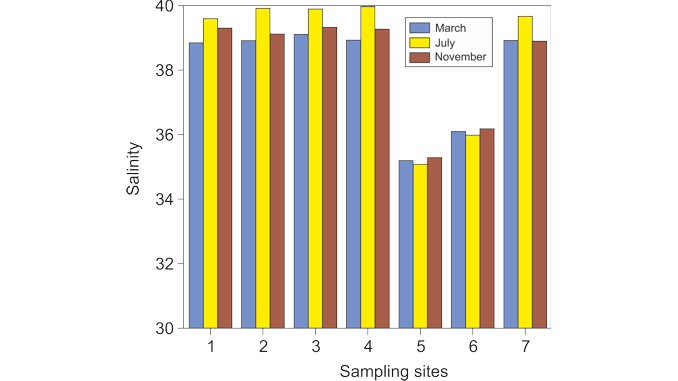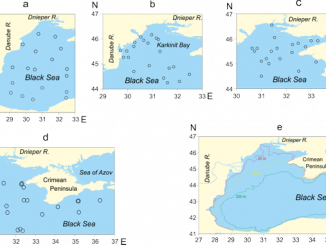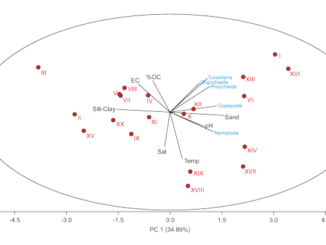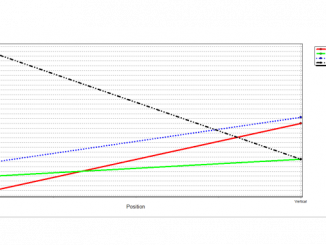
Paper category: Original research paper
Corresponding author: Mohsen M. El-Sherbiny (ooomar@kau.edu.sa)
DOI: 10.1515/ohs-2020-0018
Received: 01/10/2019
Accepted: 05/11/2019
Full text: here
Citation (APA style): Oceanological and Hydrobiological Studies, Volume 49, Issue 2, Pages 193–205, eISSN 1897-3191, ISSN 1730-413X, DOI: https://doi.org/10.1515/ohs-2020-0018.
Abstract
Seasonal distribution and diversity of surface phytoplankton have been studied in relation to anthropogenic activities at seven locations along the coastal waters of Jeddah, Saudi Arabia in 2017. The concentration of nitrite, nitrate, ammonia, phosphate and silicate varied over wide ranges: 0.04–20.27, 0.05–29.3, 0.22–78.16, 0.02–25.90 and 43–24.50 µmol l−1, respectively. Inorganic nutrients, phytoplankton biomass and density were at eutrophic levels at two lagoon locations (4 and 5), while other coastal locations showed oligotrophic characteristics of the Red Sea. Phytoplankton biomass was positively correlated with all measured inorganic nutrients. The total phytoplankton density varied between 52.4 × 103 and 40800 × 103 cells m−3 (average 6249.9 × 103 ± 10 797 × 103 cells m−3). A total of 174 species of phytoplankton (95 diatoms, 75 dinoflagellates, 3 cyanophytes and 1 silicoflagellates) were recorded in this study, with the dominance of diatoms (95.1%). Higher densities observed at lagoon locations were mainly due to the proliferation of the diatom species Skeletonema costatum and Chaetoceros decipiens. In terms of diversity, dinoflagellates were more numerous than diatoms in July, otherwise mostly diatoms dominated. On the other hand, cyanophytes were more abundant in November. Based on the present study, anthropogenic activities (especially sewage effluent) in Jeddah coastal waters had a significant impact on the phytoplankton densities and diversity.
References
Abbass, S.G., Madkour, F.F. & Abu-El-Regal, M.A. (2018). Checklist of phytoplankton species in the Egyptian Red Sea Coast of Hurghada. Egypt J. Aquat. Biol. & Fish. 22: 93–101.
Al-Aidaroos, A.M., Devassy, R.P. & El-Sherbiny, M.M. (2019). Unusual dominance of harmful microalgae Pseudo-nitzschia delicatissima cf. (Cleve) Heiden in the coastal waters of Jeddah, central Red Sea. Pak. J. Bot. 51(2): 1–6.
Al-Farawati, R., Al-Maradni, A. & Niaz, R. (2008). Chemical characteristics (nutrients, fecal sterols and polyaromatic hydrocarbons) of the surface waters for Sharm Obhur, Jeddah, Eastern Coast of the Red Sea. JKAU: Mar. Sci. 19: 95–119.
Al-Harbi, S.M. & Khomayis, H.S. (2010). Eutrophication and chlorophyll-a in a severely polluted coastal water of Jeddah, Red Sea. JKAU: Mar. Sci. 21(2): 1–15.
Al-Najjar, T., Badran, M.I., Richter, C., Meyerhoefer, M. & Sommer, U. (2007). Seasonal dynamics of phytoplankton in the Gulf of Aqaba, Red Sea. Hydrobiologia 579(1): 69–83.
Banse, K. (1992). Grazing, temporal changes of phytoplankton concentrations, and the microbial loop in the open sea. In P.G. Falkowski & A.D. Woodhead, Primary productivity and biogeochemical cycles in the sea (pp. 409–440). Springer, Boston.
Dawes, C.J. (1998). Marine Botany. John Wiley & Sons.
Devassy, R.P., El-Sherbiny, M.M., Al-Sofyani, A.M. & Al-Aidaroos, A.M. (2017). Spatial variation in the phytoplankton standing stock and diversity in relation to the prevailing environmental conditions along the Saudi Arabian coast of the northern Red Sea. Mari. Biodiver. 47(4): 995–1008.
Dorgham, M.M., El-Sherbiny, M.M. & Hanafi, M.H. (2012). Vertical distribution of zooplankton in the epipelagic zone off Sharm El-Sheikh, Red Sea, Egypt. Oceanologia 54(3): 473–489.
Dowidar, N.M. (1983). The genus Ceratium from the Red Sea. J. Fac. Mar. Sci. 3: 5–37.
Dowidar, N.M., Raheem El-Din, S.A. & Aleem, A.A. (1978). Phytoplankton population in the region of Obhur (Jeddah, Saudi Arabia). Bull Fac. Sci., KAU, Jeddah 2: 271–292.
Echeveste, P., Agustí, S. & Dachs, J. (2011). Cell size dependence of additive versus synergetic effects of UV radiation and PAHs on oceanic phytoplankton. Enviro. Pollut. 159(5): 1307–1316.
El-Rayis, O.A. (1998). Environmental conditions of two red sea coastal lagoons in Jeddah. 2-Nutrients. JKAU: Mar. Sci. 9: 49–59.
El-Sayed, M.A. (2002a). Distribution and behavior of dissolved species of nitrogen and phosphorus in two coastal Red Sea lagoons receiving domestic sewage. JKAU: Mar. Sci. 13: 47–73.
El-Sayed, M.A. (2002b). Factors controlling the distribution and behavior of organic carbon and trace metals in a heavily sewage polluted coastal environment. JKAU: Mar. Sci. 13: 21–46.
El-Sherbiny, M.M., Devassy, R.P., Muller, E.M., Al-Sofyani, A.A. & Al-Aidaroos, A.M. (2019). Biodiversity and abundance of plankton communities along the coastal waters of Gulf of Aqaba, Saudi Arabia. Pak. J. Zool. 51(5): 1823–1836.
El-Sherif, Z.M. & Aboul-Ezz, S.M. (2000). Check list of plankton of the northern Red Sea. Pak. J. Mar. Sci. 9(1–2): 61–78.
Falkowski, P.G., Katz, M.E., Knoll, A.H., Quigg, A., Raven, J.A. et al. (2004). The evolution of modern eukaryotic phytoplankton. Science 305(5682): 354–360.
Gómez, F. (2013). Reinstatement of the dinoflagellate genus Tripos to replace Neoceratium, marine species of Ceratium (Dinophyceae, Alveolata). CICIMAR Oceanides 28: 1–22.
Häder, D.P. & Gao, K. (2015). Interactions of anthropogenic stress factors on marine phytoplankton. Front. Environ. Sci. 3: 14.
Howarth, R.W., Sharpley A. & Walker, D. (2002). Sources of nutrient pollution to coastal waters in the United States: Implications for achieving coastal water quality goals. Estuaries 25(4): 656–76.
Huang, Y.J., Jiang, Z.B., Zeng, J.N., Chen, Q.Z., Zhao, Y.Q. et al. (2011). The chronic effects of oil pollution on marine phytoplankton in a subtropical bay, China. Environ. Monit. Assess. 176(1–4): 517–530.
Ismael, A.A. (2015). Phytoplankton of the Red Sea. In The Red Sea (pp. 567–583). Springer, Berlin, Heidelberg.
Khalil, A.N. (1988). A seasonal study of the surface phytoplankton of the Red Sea north of Jeddah. Arab. Gulf J. Sci. Res. 6: 189–204.
Khalil, A.N., Khafagi, A.K. & Ibrahim, A.M. (1984). Preliminary survey of micro-and macrophytes South of Jeddah, Red Sea. In Proc. Symp. Coral Reef Environ. Red Sea, Jeddah: 555–576.
Kheireddine, M., Ouhssain, M., Claustre, H., Uitz, J., Gentili, B. et al. (2017). Assessing pigment-based phytoplankton community distributions in the Red Sea. Front. Mar. Sci. 4: 132.
Khomayis, H.S. (2002). The annual cycle of nutrient salts and chlorophyll-a in the coastal waters of Jeddah. Red Sea. JKAU: Mar. Sci. 13: 131–145.
Kürten, B., Khomayis, H. S., Devassy, R., Audritz, S., Sommer, U., Struck, U., El‐Sherbiny, M.M. & Al‐Aidaroos, A.M. (2015). Ecohydrographic constraints on biodiversity and distribution of phytoplankton and zooplankton in coral reefs of the Red Sea, Saudi Arabia. Mar. Ecol. 36(4): 1195–1214.
LeGresley, M. & McDermott, G. (2010). Counting chamber methods for quantitative phytoplankton analysis-haemocytometer, Palmer-Maloney cell and Sedgewick-Rafter cell. UNESCO (IOC Manuals and Guides), 25–30.
Madkour, F.F. (2010). Phytoplankton population along certain Egyptian coastal regions of the Red Sea. Egypt J. Aquat. Biol. & Fish. 14(2): 95–109.
Mann, D.G. (1999). The species concept in diatoms. Phycologia 38(6): 437–495.
Matthews, J.A. (2013). Encyclopedia of Environmental Change: Three Volume Set. Sage.
McIntyre, A.D. (1995). Human impact on the oceans: the 1990s and beyond. Mar. Pollut. Bull. 31(4–12): 147–151.
Mishra, S., Sahu, G., Mohanty, A.K., Singh, S.K. & Panigrah, R.C. (2006). Impact of the diatom Asterionella glacialis (Castracane) bloom on the water quality and phytoplankton community structure in coastal waters of Gopalpursea, Bay of Bengal. Asian J. Water Environ. Pollut. 3: 71–77.
Nassar, M.Z.A. & Khairy, H.M. (2014). Checklist of phytoplankton species in the Egyptian waters of the Red Sea and some surrounding habitats (1990–2010). Annu. Res. Rev. Biol. 4(23): 3566–3585.
Nixon, S.W. (1995). Coastal marine eutrophication: a definition, social causes, and future concerns. Ophelia 41(1): 199–219.
Officer, C.B. & Ryther, J.H. (1980). The possible importance of silicon in marine eutrophication. Mar. Ecol. Prog. Ser. 3(1): 83–91.
Paerl, H.W. (1997). Coastal eutrophication and harmful algal blooms: Importance of atmospheric deposition and groundwater as “new” nitrogen and other nutrient sources. Limno. Oceanogr. 42(5part2): 1154–1165.
Parsons, T.R., Maita, Y. & Lalli, C.M. (1984). A Manual of Biological and Chemical Methods for Seawater Analysis. Pergamon Press, Oxford, London.
Peña-García, D., Ladwig, N., Turki, A.J. & Mudarris, M.S. (2014). Input and dispersion of nutrients from the Jeddah Metropolitan Area, Red Sea. Mar. Pollut. Bull. 80(1): 41–51.
Pinckney, J.L., Paerl, H.W., Tester, P. & Richardson, T.L. (2001). The role of nutrient loading and eutrophication in estuarine ecology. Environ. Health Perspect. 109(suppl 5): 699–706.
Post, A.F., Veldhuis, M. & Lindell, D. (1996). Spatial and temporal distribution of ultraphytoplankton in the Gulf of Aqaba, Red Sea. J. Phycol. Suppl. 32: 38–39.
Post, A.F., Dedej, Z., Gottlieb, R., Li, H., Thomas, D.N. et al. (2002). Spatial and temporal distribution of Trichodesmium spp. in the stratified Gulf of Aqaba, Red Sea. Mar. Ecol. Prog. Ser. 239: 241–250.
Qurban, M.A., Krishnakumar, P.K., Joydas, T.V., Manikandan, K.P., Ashraf, T.T.M. et al. (2014). In-situ observation of deep water corals in the northern Red Sea waters of Saudi Arabia. Deep Sea Res. Part I Oceanogr. Res. Pap. 89: 35–43.
Qurban, M.A., Wafar, M., Jyothibabu, R. & Manikandan, K.P. (2017). Patterns of primary production in the Red Sea. J. Mar. Res. 169: 87–98.
Reynolds, C.S. (2006). The ecology of phytoplankton. Cambridge University Press.
Shaikh, E.A., Roff, J.C. & Dowidar, N.M. (1986). Phytoplankton ecology and production in the Red Sea off Jiddah, Saudi Arabia. Mar. Biol. 92(3): 405–416.
Sommer, U. (2000). Scarcity of medium-sized phytoplankton in the northern Red Sea explained by strong bottom-up and weak top-down control. Mar. Ecol. Prog. Ser. 197: 19–25.
Steele, J.H. (1985). A comparison of terrestrial and marine ecological systems. Nature 313(6001): 355.
Taylor, F.J.R. (1976). Dinoflagellates from the International Indian Ocean Expedition. A report on material collected by the R.V. “Anton Bruun” 1963–1964. Bibl. Bot. 132: 1–234.
Tomas, C.R. (1997). Identifying Marine Phytoplankton. UNESCO. Protocols for the joint global ocean flux study (JGOFS), Manual and Guides 29, Academic press, USA.
Touliabah, H.E., Abu El-Kheir, W.S., Kuchari, M.G. Abdulwassi, N.I.H. (2010). Phytoplankton composition at Jeddah Coast-Red Sea, Saudi Arabia in relation to some ecological factors. JKAU: Mar Sci. 22(1): 151–131.




Bądź pierwszy, który skomentuje ten wpis